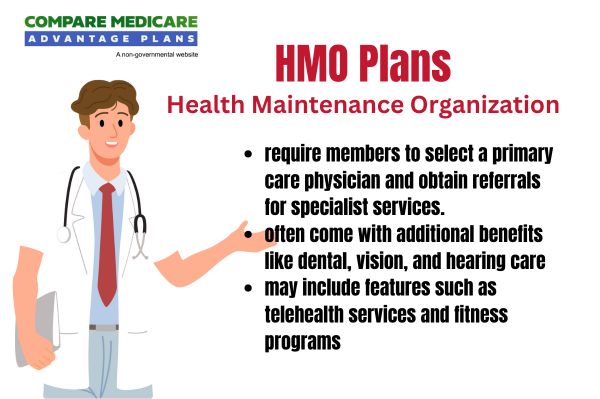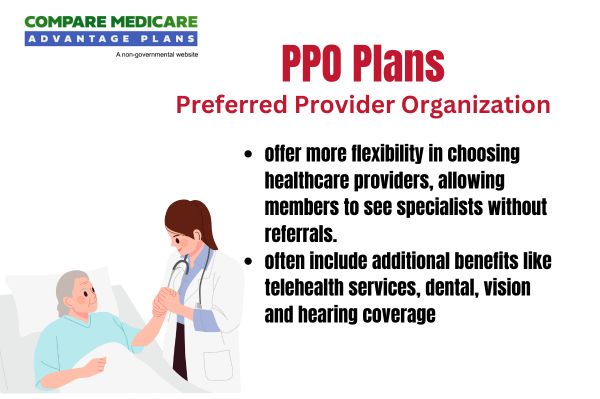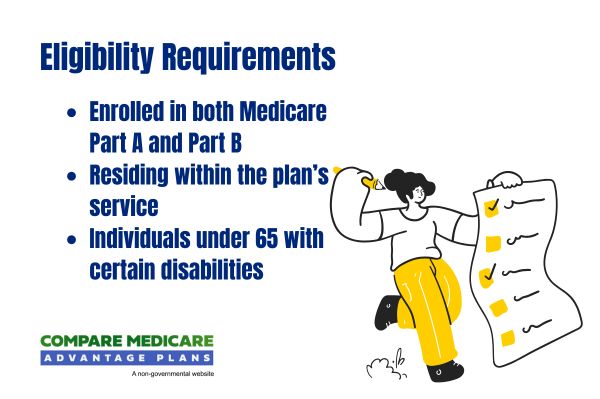




Medicare Advantage Plans Oregon 2026
Looking for details on the Medicare Advantage plans in Oregon
Key Takeaways
- Certain Oregon Medicare Advantage plans may provide a range of benefits that could go beyond traditional Medicare, which may include dental, vision, and hearing coverage, as well as prescription drug coverage.
- There are several types of Medicare Advantage plans available in Oregon, including HMO, PPO, and Special Needs Plans (SNPs), each offering unique features and flexibility in accessing care.
- The enrollment process for Medicare Advantage involves specific periods, such as Initial Enrollment and Annual Enrollment, allowing beneficiaries to adjust their plans according to their healthcare needs.
Compare Plans in One Step!
Enter Zip Code
Understanding Oregon Medicare Advantage Plans 2026

Medicare Advantage plans could offer an alternative to traditional Medicare by providing coverage through private insurers, combining Medicare Part A and Part B benefits. Eligibility requires enrollment in both Medicare Part A and Part B. Some plans might include extra benefits like prescription drug coverage, unlike Original Medicare.
These plans may have network restrictions that require members to use in-network healthcare providers. Oregon residents could choose from various Medicare Advantage plans differing in costs, coverage, and provider networks. These plans will likely offer a range of options to suit diverse healthcare needs, likely making it crucial to understand what each type entails.
Types of Oregon Medicare Advantage Plans Available
Oregon will likely offer a variety of Medicare Advantage plans, each with unique features and coverage options. Major types include Health Maintenance Organization (HMO) plans, Preferred Provider Organization (PPO) plans, and Special Needs Plans (SNPs).
Knowing the differences between these plans might help in choosing the best fit for your healthcare needs.
HMO Plans

Health Maintenance Organization (HMO) plans typically require members to select a primary care physician and obtain referrals for specialist care. This approach could ensure coordinated care, but may limit your choice of healthcare providers to the plan’s network. However, emergency services may be covered even if the provider is outside the plan’s network.
HMO plans could potentially offer lower premiums and out-of-pocket costs compared to other Medicare Advantage plans. Some plans may also include additional benefits like dental and vision care, not covered by Original Medicare. These plans will likely be ideal for those seeking cost-effective healthcare options with access to essential services.
PPO Plans

PPO plans offer greater flexibility in choosing healthcare providers, including the option to see out-of-network providers at a higher cost. This flexibility could be beneficial for those who want the freedom to select their doctors and specialists without needing referrals. Using in-network providers might result in lower costs, possibly balancing flexibility and savings effectively.
Some PPO plans may also include additional benefits like dental, vision, and hearing coverage. These plans might vary in monthly premiums and deductibles, likely offering various choices to fit different budgets and healthcare needs.
Special Needs Plans (SNPs)

Special Needs Plans (SNPs) cater to individuals with specific health conditions or characteristics, likely offering tailored benefits and services. These plans cater to those with chronic conditions, dual eligibility for Medicare and Medicaid, or those living in care facilities. SNPs provide all standard Medicare Part A and Part B benefits, and sometimes with additional benefits.
Enrollment in an SNP requires having Medicare Part A and Part B, residing within the plan’s service area, and meeting specific health-related eligibility criteria. SNPs could be an excellent option for those needing specialized care and support, possibly offering a more focused approach to managing their health.
Overview of Oregon Medicare Advantage Plans 2026
Some Medicare Advantage Plans in Oregon may provide an out-of-pocket limit for certain Medicare Part D plans, which could potentially lower drug expenses for beneficiaries. The possible elimination of the coverage gap, known as the donut hole, could potentially relieve many beneficiaries from high out-of-pocket medication costs.
These potential changes could help improve healthcare access and affordability for Oregon residents.
Covered Services and Potential Benefits
Some Medicare Advantage plans in Oregon may cover a wide array of additional services and benefits. Certain plans may offer vision, dental, and hearing benefits, which are not covered by traditional Medicare.
These potential benefits could make certain Medicare Advantage plans a comprehensive option for many.
Possible Benefits of Oregon Medicare Advantage Plans 2026

Some Oregon Medicare Advantage plans could potentially offer numerous additional benefits, which may include dental, vision, and hearing coverage, which are not typically offered by Original Medicare. Certain plans may also have lower out-of-pocket costs, possibly making healthcare more affordable for enrollees.
Bundling services like hospital and outpatient coverage into a single health plan, Medicare Advantage plans could potentially simplify healthcare management.
Enrollment Process for Oregon Medicare Advantage Plans 2026

Enrolling in Medicare Advantage plans in Oregon involves several steps and periods. Enrollment in a Medicare Advantage Plan requires having both Medicare Part A and Part B.
The Medicare Open Enrollment period, running annually from October 15 to December 7, allows Oregon residents to review and modify their Medicare coverage for the upcoming year. Knowing when and how to enroll ensures continuous and comprehensive healthcare coverage.
When to Enroll
Enrollment for Medicare Advantage plans can be initiated during the initial open enrollment period, which occurs from January 1 to March 31. The Initial Enrollment Period starts three months before Medicare eligibility and lasts for three months after. Enroll by December 31 to ensure coverage starts in January the following year.
The Annual Enrollment Period starts on October 15 of each year. If their plan is discontinued, members can use a Special Enrollment Period from December 8 to February 28. This allows them to choose a new plan during that time. This flexibility helps individuals maintain continuous coverage and access to necessary healthcare services.
Different Enrollment Periods
Aside from general open enrollment, beneficiaries can change their Medicare Advantage plans during the annual enrollment period each fall. The Open Enrollment Period from October 15 to December 7 allows beneficiaries to enroll, switch, or drop plans. Enrollment periods, including the Initial Enrollment, Open Enrollment, and Special Enrollment Periods, offer specific times for individuals to enroll in a Medicare Advantage Plan.
The Initial Enrollment Period starts three months before Medicare eligibility and extends three months after. From January 1 to March 31, individuals already in a Medicare Advantage Plan can switch plans or revert to Original Medicare.
Special Enrollment Periods are available for those facing certain life events, such as relocating or losing current coverage. These periods offer multiple opportunities to adjust coverage as needed.
OEP, AEP, and Special Enrollment
Special enrollment periods are available for individuals experiencing certain life changes, such as losing Medicaid coverage. Triggered by specific life events, these periods allow beneficiaries to adjust their plans outside of regular enrollment times.
The Medicare Annual Enrollment Period (AEP), from October 15 to December 7 each year, allows beneficiaries to modify their Medicare plans for the upcoming year. The Medicare Open Enrollment Period (OEP) for Medicare Advantage plans runs from January 1 to March 31, allowing current enrollees to switch plans or revert to Original Medicare.
During AEP, beneficiaries can enroll in a different Medicare Advantage plan or adjust their Part D prescription drug coverage. Changes during the OEP are limited, allowing only one switch to a different Medicare Advantage plan or a return to Original Medicare. This flexibility ensures beneficiaries can adapt their coverage to changing healthcare needs.
Potential Costs Associated with Oregon Medicare Advantage Plans 2026

Costs associated with Medicare Advantage plans in Oregon may vary widely depending on the specific plan chosen. Knowing these potential costs will likely be crucial for making informed healthcare coverage decisions.
Premiums and Co-Pays
Monthly premiums for certain Medicare Advantage plans may vary significantly based on the chosen plan and geographic location. Some plans may offer lower premiums and copayments compared to Original Medicare. A deductible may also be required before the plan covers certain services. Co-pays are fixed amounts for specific services, such as a set fee for doctor visits.
Coinsurance could be another consideration, as these represent a percentage of the cost that members pay after meeting their deductible. When evaluating total plan costs, members should consider both co-pays and coinsurance. Understanding these components could help you anticipate healthcare expenses and choose a plan that aligns with your financial situation.
Out-of-Pocket Maximums
Some Medicare Advantage plans may offer a limit on out-of-pocket expenses for covered medical care, possibly protecting members from high costs. The out-of-pocket maximum varies by plan. Once this limit is reached, plans will likely cover all additional costs for the year, possibly providing a financial safety net for beneficiaries.
Knowing these potential limits could be crucial for planning your healthcare budget and potentially avoiding unexpected expenses.
How to Qualify for Oregon Medicare Advantage Plans 2026
Qualification for Oregon Medicare Advantage plans requires enrollment in Medicare Part A and Part B. Enrollees must also reside within the service area of the desired Medicare Advantage plan. Some plans are designed for individuals with special needs, which may include additional qualification criteria. Applicants cannot be enrolled in another Medicare Advantage plan.
Eligibility extends to those aged 65 and older or those under 65 with qualifying disabilities, including residents with end-stage renal disease (ESRD) or amyotrophic lateral sclerosis (ALS). The enrollment process can begin three months before turning 65 and extends for three months after the birthday month.
Comparing Oregon Medicare Advantage Plans to Original Medicare
Certain Medicare Advantage plans in Oregon might integrate additional services such as vision, hearing, and dental care, which are not available with Original Medicare.
Understanding these potential differences could help you decide which type of plan best suits your healthcare needs.
Coverage Differences
Some Oregon Medicare Advantage plans might incorporate prescription drug coverage, whereas Original Medicare does not inherently provide prescription drug benefits. Some plans may also offer additional benefits not included in Original Medicare, like vision, dental, and hearing coverage.
While Original Medicare includes Parts A and B, Medicare Advantage often bundles these with prescription drug coverage as part of one plan. However, Medicare Advantage plans may have different networks of doctors and hospitals compared to Original Medicare, affecting provider access. These differences could significantly impact your healthcare experience and costs.
Cost Comparisons
While Original Medicare will likely have standardized costs, the out-of-pocket expenses for certain Oregon Medicare Advantage plans may vary significantly based on the specific plan selected.
Cost-sharing elements like deductibles and co-pays may also differ widely among plans, likely impacting overall affordability. Additional benefits, such as dental and vision coverage, could also influence the total costs of these plans.
Members can use this website to compare and evaluate the potential costs against the possible benefits of various plans.
Emergencies and Referrals

Medicare Advantage plans allow access to emergency services without requiring a referral. For urgent care visits, members may seek care outside their network without needing prior authorization. In emergency situations, Medicare Advantage plans cover services provided by any emergency room that accepts Medicare.
Summary
Oregon Medicare Advantage plans
Frequently Asked Questions
→ What are the eligibility requirements for enrolling in a Medicare Advantage plan in Oregon?
To enroll in a Medicare Advantage plan in Oregon, you must be enrolled in Medicare Part A and Part B and live within the plan’s service area. Ensure that you meet these criteria to take advantage of the benefits offered.
→ What types of Medicare Advantage plans are available in Oregon?
Oregon will likely offer several types of Medicare Advantage plans, including HMO, PPO, and Special Needs Plans (SNPs), each with distinctive features tailored to different healthcare needs. It’s important to choose the one that best aligns with your personal health circumstances.
→ What is the difference between Original Medicare and Medicare Advantage plans?
The primary difference is that some Medicare Advantage plans may offer additional benefits like dental, vision, and hearing coverage that Original Medicare does not provide. Therefore, if you seek comprehensive coverage, a Medicare Advantage plan may be more suitable for your needs.
→ How might the costs of Medicare Advantage plans compare to Original Medicare?
Unfortunately, the plan details
→ When can I enroll in a Medicare Advantage plan?
You can enroll in a Medicare Advantage plan during the Initial Enrollment Period, the Annual Enrollment Period from October 15 to December 7, or during a Special Enrollment Period for specific life events. It’s important to be aware of these timeframes to ensure you secure your coverage.

ZRN Health & Financial Services, LLC, a Texas limited liability company



